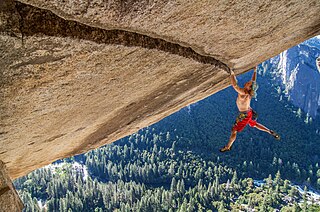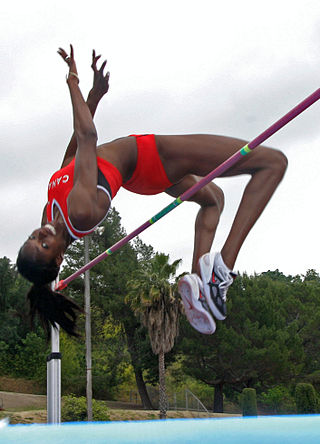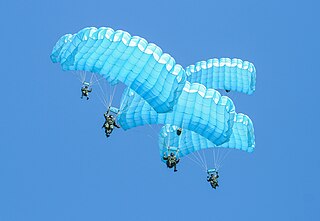
Climbing is the activity of using one's hands, feet, or other parts of the body to ascend a steep topographical object that can range from the world's tallest mountains to small boulders. Climbing is done for locomotion, sporting recreation, for competition, and is also done in trades that rely on ascension, such as rescue and military operations. Climbing is done indoors and outdoors, on natural surfaces, and on artificial surfaces

Gymnastics is a type of sport that includes physical exercises requiring balance, strength, flexibility, agility, coordination, artistry and endurance. The movements involved in gymnastics contribute to the development of the arms, legs, shoulders, back, chest, and abdominal muscle groups. Gymnastics evolved from exercises used by the ancient Greeks that included skills for mounting and dismounting a horse, and from circus performance skills.

The high jump is a track and field event in which competitors must jump unaided over a horizontal bar placed at measured heights without dislodging it. In its modern, most-practiced format, a bar is placed between two standards with a crash mat for landing. Since ancient times, competitors have introduced increasingly effective techniques to arrive at the current form, and the current universally preferred method is the Fosbury Flop, in which athletes run towards the bar and leap head first with their back to the bar.

The long jump is a track and field event in which athletes combine speed, strength and agility in an attempt to leap as far as possible from a takeoff point. Along with the triple jump, the two events that measure jumping for distance as a group are referred to as the "horizontal jumps". This event has a history in the ancient Olympic Games and has been a modern Olympic event for men since the first Olympics in 1896 and for women since 1948.

The triple jump, sometimes referred to as the hop, step and jump or the hop, skip and jump, is a track and field event, similar to long jump. As a group, the two events are referred to as the "horizontal jumps". The competitor runs down the track and performs a hop, a bound and then a jump into the sand pit. The triple jump was inspired by the ancient Olympic Games and has been a modern Olympics event since the Games' inception in 1896.
Show jumping is a part of a group of English riding equestrian events that also includes eventing, hunters, and equitation. Jumping classes are commonly seen at horse shows throughout the world, including the Olympics. Sometimes shows are limited exclusively to jumpers. Sometimes jumper classes are offered in conjunction with other English-style events. Sometimes, show jumping is but one division of a very large, all-breed competition that includes a very wide variety of disciplines. Jumping classes may be governed by various national horse show sanctioning organizations, such as the United States Equestrian Federation or the British Showjumping Association. International competitions are governed by the rules of the International Federation for Equestrian Sports.

Water skiing is a surface water sport in which an individual is pulled behind a boat or a cable ski installation over a body of water, skimming the surface on two skis or one ski. The sport requires sufficient area on a stretch of water, one or two skis, a tow boat with tow rope, two or three people, and a personal flotation device. In addition, the skier must have adequate upper and lower body strength, muscular endurance, and good balance.

Ski jumping is a winter sport in which competitors aim to achieve the farthest jump after sliding down on their skis from a specially designed curved ramp. Along with jump length, competitor's aerial style and other factors also affect the final score. Ski jumping was first contested in Norway in the late 19th century, and later spread through Europe and North America in the early 20th century. Along with cross-country skiing, it constitutes the traditional group of Nordic skiing disciplines.
Freestyle skiing is a skiing discipline comprising aerials, moguls, cross, half-pipe, slopestyle and big air as part of the Winter Olympics. It can consist of a skier performing aerial flips and spins and can include skiers sliding rails and boxes on their skis. Known as "hot-dogging" in the early 1970s, it is also commonly referred to as freeskiing, jibbing, as well as many other names, around the world.

Calisthenics or callisthenics (/ˌkælɪsˈθɛnɪk/) is a form of strength training that utilizes an individual's body weight as resistance to perform multi-joint, compound movements with little or no equipment.

The Fosbury flop is a jumping style used in the track and field sport of high jump. It was popularized and perfected by American athlete Dick Fosbury, whose gold medal in the 1968 Summer Olympics in Mexico City brought it to the world's attention. The flop became the dominant style of the event; before Fosbury, most elite jumpers used the straddle technique, Western Roll, Eastern cut-off, or scissors jump to clear the bar. Though the backwards flop technique had been known for years before Fosbury, landing surfaces had been sandpits or low piles of matting and high jumpers had to land on their feet or at least land carefully to prevent injury. With the advent of deep foam matting, high jumpers were able to be more adventurous in their landing styles and hence more experimental with jumping styles.
Aerial techniques, also known as "high-flying moves" are performance techniques used in professional wrestling for simulated assault on opponents. The techniques involve jumping from the ring's posts and ropes, demonstrating the speed and agility of smaller, nimble and acrobatically inclined wrestlers, with many preferring this style instead of throwing or locking the opponent.

Plyometrics, also known as jump training or plyos, are exercises in which muscles exert maximum force in short intervals of time, with the goal of increasing power (speed-strength). This training focuses on learning to move from a muscle extension to a contraction in a rapid or "explosive" manner, such as in specialized repeated jumping. Plyometrics are primarily used by athletes, especially martial artists, sprinters and high jumpers, to improve performance, and are used in the fitness field to a much lesser degree.

Chinese jump rope, also known as Chinese ropes, jumpsies, elastics, rek, yoki (Canada), Super Cali (Newfoundland), French skipping, American ropes/Chinese ropes, gummitwist, "jeu de l elastique" in France and Chinese garter in the Philippines is a children's game resembling hopscotch and jump rope. Various moves are combined to create patterns which are often accompanied by chants.
Chinese jump rope combines the skills of hopscotch with some of the patterns from the hand-and-string game cat's cradle. The game began in 7th-century China. In the 1960s, children in the Western hemisphere adapted the game. German-speaking children call Chinese jump rope gummitwist and British children call it elastics. The game is typically played in a group of at least 3 players with a rope approximately 16 feet in length tied into a circle. Traditional Chinese jump ropes are strings of rubber bands tied together, but today many varieties of commercial rope exist. Two players face each other standing 9 feet apart, and position the rope around their ankles so that it is taut. The third player stands between the two sides of the rope and tries to perform a designated series of moves without making an error or pausing.
A skipping rhyme, is a rhyme chanted by children while skipping. Such rhymes have been recorded in all cultures where skipping is played. Examples of English-language rhymes have been found going back to at least the 17th century. Like most folklore, skipping rhymes tend to be found in many different variations. The article includes those chants used by English-speaking children.

Double Dutch is a game in which two long jump ropes turning in opposite directions are jumped by one or more players jumping simultaneously. It is believed to have originated among Dutch immigrants in New York City, although it has been a popular school playground game for much longer than that in the Netherlands, and is now popular worldwide. While it had long been a popular street activity for African American girls in New York City, the modern sport of Double Dutch originated in the early 1970s with NYPD officers Ulysses Williams and David Walker, who formalized the rules for competition. The first official competition was held in 1974. Competitions in Double Dutch range from block parties to the world level. During the spring of 2009, Double Dutch became a varsity sport in New York City public high schools.
This is a general glossary of the terms used in the sport of gymnastics.

Parachuting and skydiving is a method of transiting from a high point in an atmosphere to the ground or ocean surface with the aid of gravity, involving the control of speed during the descent using a parachute or parachutes.

Physical training has been present in human societies throughout history. Usually, it was performed for the purposes of preparing for physical competition or display, improving physical, emotional and mental health, and looking attractive. It took a variety of different forms but quick dynamic exercises were favoured over slow or more static ones. For example, running, jumping, wrestling, gymnastics and throwing heavy stones are mentioned frequently in historical sources and emphasised as being highly effective training methods. Notably, they are also forms of exercise which are readily achievable for most people to some extent or another.
The International Jump Rope Union (IJRU) is the highest authority and world governing body for the sport of jump roping and rope skipping.






















